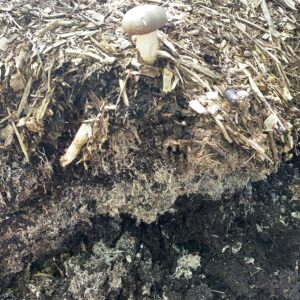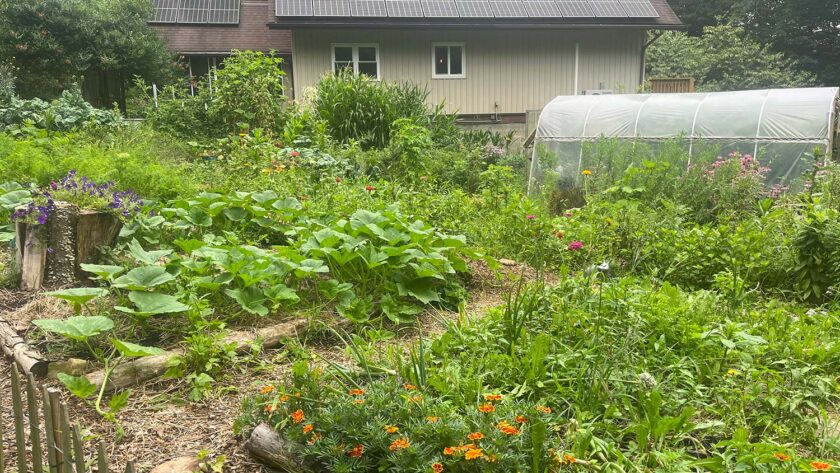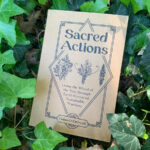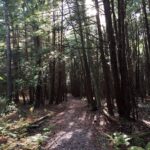Recently I had some local homesteaders visit who wanted to see our homestead and the various systems we’ve been building. At one point, I uprooted a dandelion that was growing in a bed and the whole root just came right up–and one of them said, “wow, look at that soil.” And to anyone with a practiced eye, they know that building good soil is the key to everything else: it is the key to helping plants fight pests and disease, it is the key to abundant and rich yields, and it is the key to fostering a healthy and balanced ecosystem. I also attend to soil building a lot as we are wrapping up the growing season, because this is a good time to do so: with abundant fall leaves, composts coming into maturity, and cover crops, the time between the Fall Equinox and the Winter Solstice is what I consider to be “prime soil time”!
Today’s post is the second part in my blog series on soil. My post from a few weeks ago, Secrets in the Soil: Understanding the Soil Web of Life, described the incredible soil web of life and explored the rich and sacred interactions. In this post, I share some methods for soil building such as hugelkultur, biochar, and innovative methods of composting, and then we’ll move on to ceremonial, meditative, and sacred practices with soil and the soil web of life in next week’s post!
Cultivating Healthy Soil: Foundations

Many of the people I learned organic and regenerative gardening from had a saying, “We aren’t growing plants, we are growing soil.” The more that you start to see the interconnection between soil, plants, and growing, you can understand the truth of this statement. Soil is the foundation upon which everything else happens, and without a healthy soil web, nature cannot flourish. Soil imbalances lead to extra pests, disease, less abundance, and damaged plants. Soil ecology and soil composition determine what grows well and what struggles. If you are doing any annual gardening, the balance becomes so much more important to monitor and address. So the question for today is: how do we cultivate healthy soils?
Avoid Tilling at All Costs
The first and most important thing you can do for building soil is to stop tilling. What does tilling do? Tilling does two problematic things: for one, it disrupts and destroys the soil web including the mycelial connections (see mycorrhizia below), which creates depleted soil. Tilling also increases soil compaction, soil erosion, and the depletion of nutrients in the soil. Certain soil bacteria in the soil are stimulated by tilling, causing them to go on a rampage to eat all of the organic matter and then die back in large quantities, which depletes and unbalances the soil–and repeated tilling can kill all the life in the soil. Second, you disturb weed seeds, which results in the need for more tilling or pesticides to kill weeds. You compromise the lighter structure of the soil, which results in more runoff and loss of nutrients. I can’t really comprehend how tilling is still a common practice with so many drawbacks.
What this does in the long term is create a situation where you have to apply lots of pesticides to deal with the weeds and lots of imported nutrients–and then you have conventional farming.
Mycorrhizal Fungal Networks
Fungal networks form one of the most important parts of a healthy soil web, with many plants and trees depending on fungal networks to exchange nutrients. In the case of mushrooms like chanterelles, amanitas, boletes, black trumpets, and many more, these mushrooms grow in ways that are symbiotic with the perennial trees and plants where they grow–they attach to root systems and help move nutrients, exchanging minerals for carbohydrates that plants can generate through photosynthesis. This allows for communication across tree species and in the forest. Not tilling is one of the best things you can do for soil health. You can also purchase mycorrhizal fungi to add to trees when you plant or add in your own spores!

Emphasize Perennials
Perennial structures bind with mycorrhizal fungal networks to create a more stable soil web–and this is what mimics nature in the forest or any other ecosystem. We like to use a combination of perennials and annuals in our garden areas–some beds are more annual-focused and some beds have only a few places for annuals and are more perennial in nature. By attending to the balance of your annuals and perennials, and by creating “guilds” as they are known in permaculture (where plants work together and grow together) you can support a healthy soil web.
Soil Building: Techniques
This section will share some techniques for building soil–creating new beds or bringing tired beds back to life.
Lasagna Gardening/Sheet Mulching
This is a simple soil-building technique that is widely used and uses a number of “waste” materials that you can usually find for free–cardboard, newspaper, fall leaves, and other brown and green compost. I like to do this at the end of the season as a way of resetting the gardens, dealing with weeds, and so forth. More information on the basic technique can be found here, and dealing with weedy areas can be found here. We use this as one of our two primary garden bed-building approaches (the other being Hugelkultur, next). We often sheet mulch at the end of the growing season to suppress weeds, give new organic matter to beds, and build soil for the coming season. This allows us to “put the beds to sleep” for the season.
Hugelkultur
My favorite technique of those listed here is Hugelkultur, a German word that refers to the specific wood and debris-filled beds that build soil fertility, hold moisture, and grow rich and abundant over time. Hugelkultur (hugels for short) are incredible ways to use extra wood, sink carbon, and create high-performing beds. I’ve been extremely happy with how effective these beds have been on our homestead–they grow very tall, abundant, and healthy plants and hold a lot of moisture. We now have hugel beds that are five years old and are really able to handle temperature fluctuations and drought in ways the other beds (that are sheet mulched) cannot. I have a full overview of hugelkutur techniques on the blog here and some more info on the forest hugels we’ve been building here.
Biochar
Another great way to sink carbon and build healthy soil is using biochar. I have less experience with this technique than others (primarily due to the needs of our land) but I have made it with friends and have witnessed the effects of it in many places. Biochar is partially combusted organic matter; this is where you use a specific technique to limit the oxygen after you have set woody material on fire. The way I learned it is by taking a lot of hardwood, digging a bit, lighting the hardwood on fire and making sure it was going good, and then covering the pit with soil, which effectively limited the oxygen. This rich material was then used to enrich garden beds, used when planting trees, etc. Here are a few links on biochar to get you started: biochar (with linked videos), info on biochar from the Permaculture Institute.
Dynamic Accumulators and Nitrogen Fixers
There are a host of different things you can do in terms of planting to help plant plants that work together and enrich the soil by their presence. These two kinds of plants are dynamic accumulators and nitrogen fixers. Dynamic Accumulators is a term used in permaculture that describes plants that can accumulate nutrients–either from deep tap roots that can bring up nutrients or from the air around them. Often, you see these either in companion plantings or planting to support healthy ecologies, such as guild plantings under fruit trees. This website offers a good list of dynamic accumulators–with comfrey and nettles being two that many people know well. Another plant type is the nitrogen fixer, a plant that “fixes” nitrogen in the soil, usually in their roots. Legumes (beans, peas) and certain shrubs trees (black locust, autumn olive) are nitrogen fixer plants. This is one reason to always cut your beans at the base of the plant at the end of the season rather than uproot them–this allows the nitrogen they have accumulated to stay in the soil!
Generating Compost

Obviously, a lot of the above bed maintenance and building techniques are rooted in the ability to produce compost. Because of our flocks, we primarily compost through the means of our chicken flocks, and build a lot of wonderful compost piles from animal waste from their coops and runs. This creates a very closed loop system where we are producing a lot of our own compost. I’ve written a lot on compost over many years, so you might check out more details A Guide to Composting with Tumblers, Sheet Mulching, Worms, Chickens, and Piles, Vermicomposting I: Setting Up Your Worm Bin, The Basics of Composting, Permaculture Design, and Inventive Composting Techniques for City Dwellers.
One of the things you need to be aware of is that if you are importing your compost, killer compost is a serious concern. Killer compost refers to composts that have residue of herbicide, pesticide, or fungicide–and this is way more common than you think (a simple Google search will reveal so many stories of people dealing with this). This link offers a simple test for how you can see if your compost has these issues and what to look for and this link also provides some good information. We actually had this problem this year–my first experience with it. We were building a lot of new beds this year, including three 8×8′ raised hugel beds. We didn’t generate enough of our own compost to fill these beds, so we imported some from a local place that we get a lot of things from (stones, gravel, etc.). We’ve gotten it from there a few times before without trouble. This year though, every bed that had that particular batch of compost had the tell-tale signs–withered and curled leaves, almost no yield, plants that were dying right in the ground the week after we put them in. It really affirmed to me that you can get hit with this at any point and has had us redouble our efforts to generate more compost and/or find local sources of manure.
Soil Web Maintenance Practices
The following practices offer some suggestions for how to maintain beds in the soil web.
Using Green Manures, Cover crops, and Living Mulches

One favorite of mine for supporting the soil is using cover crops, living mulches, and green manures. Bare soil is never found in nature, and bare soil can lead to erosion and compaction. Adding in cover crops for the winter (such as winter rye) or growing in things like clover can help you keep your soil structure and fertility intact. I wrote about cover crops here. This upcoming year, we will be experimenting more with living mulches–I’ll keep you updated. The additional benefit of winter cover crops is that our geese really love to eat them, and then they poop and add more nutrition to the soil!
Avoid Stepping or Compacting Beds
Another simple strategy to avoid soil compaction is to not step on the beds and not use any heavy machinery on beds. We do this–our beds are generally 4′ across in all areas, with some being 4×20′ and others being a 12×12′ keyhole bed with stepping areas. This way, we never walk on our beds, which prevents compaction. As long as you can work all the areas of your bed and lean in, you can avoid compacting the soil. This is a very simple and effective way of honoring the soil web.
Removing Annual Plants at the end of the Season
If they are annual plants like beans, corn, squash, and tomatoes and you want to remove those to compost and put in a cover crop, the best thing to do is to cut the plant right at the root. This allows the soil web to stay intact. The roots will break down as they decompose, adding more organic matter to the soil. Then you can mulch right on top or plant in bewteen last year’s roots. This also helps preserve the fungal web of life.
Aeration: Broadfork
If you do need to aerate the soil, you can use a broadfork or garden fork or . Place the tines into the soil and gently lift, adding just a bit of air. I don’t like to do that too often though–as long as I avoid soil compaction in the first place, the broadfork doesn’t need to come out too often.

Aeration: Turnip or Radish Cover Crop
Radishes, turnips, or other plants that break up compacted soil can also be really helpful to grow in beds that need some additional support and are compacted. You can let them rot over the winter and then they will add space to your soil.
Crop Rotation and Three Sisters
Rotating your annual crops to ensure that the same broad categories of crops are not growing in the same space year after year is another solid soil-honoring idea. Crop rotation generally is based on categories: Solanaceae (Tomatoes, peppers, potatoes, eggplant) are heavy feeders, and can be followed up by Legumes (beans, peas) and then rotated into root veggies or cucurbits. By ensuring that you aren’t planting the same crop in the same space at least for three years ensures a healthy soil web with balanced nutrition.
A take on this is the Three Sisters garden, an indigenous gardening technique that balances the needs of three crops: corn, beans, and squash. The corn has a very deep root system and grows tall, offering a place for squash and beans to climb. Beans provide nitrogen, and the broad leaves of the squash shade out the soil and reduce other competition. The three sisters also provide balanced nutrition when eaten together.
Conclusion
I hope this post has helped illustrate some of the many ways you can build wonderful soil fertility in your garden and also some techniques for honoring the soil web. I’ll follow up this post soon by exploring ceremonies, meditations, and spiritual practices for honoring the soil.
Announcement: Druid’s Book Volume II is Available now!
 I’m very pleased to announce that the Ancient Order of Druids in America has released the The Druids Book of Ceremonies, Songs, and Prayers, Volume II. This book features as the title suggests: ceremonies, rituals, songs, prayers, poetry, and all sorts of other good things to deepen your druid practices. I served as Chief Editor, cover artist, and illustrator on this project. I also have two ritual practices in this book. Please check it out on Amazon!
I’m very pleased to announce that the Ancient Order of Druids in America has released the The Druids Book of Ceremonies, Songs, and Prayers, Volume II. This book features as the title suggests: ceremonies, rituals, songs, prayers, poetry, and all sorts of other good things to deepen your druid practices. I served as Chief Editor, cover artist, and illustrator on this project. I also have two ritual practices in this book. Please check it out on Amazon!




When I started my garden in Fryeburg, Maine in the late 1990s (and I lived there for 25 years, selling and moving to NY in 2018), it was literally beach sand. It was quite an endeavor to build that soil, but I did. Two years in, I remember planting tomato plants (bare footed) and feeling something crawling on me, looked down, delighted to see earthworms! They had finally come in. Every year I added leaf mulch, compost, the potting soil from the previous year’s flowers that were on steps, etc. planted in pots and grow bags. I also promised the garden (and the soil most especially) that I would never bring in any power tools. Everything would be done by hand. And so it was.
But one thing that became a serious issue about 10 into the garden, was the encroachment of those fine haired tree roots. There was a large Norway maple that was not far from the garden, creating what I called the forest garden area as it was shady. This was where I started my goldenseal bed, and also many other perennials and woodland plants. So it started in those beds and didn’t seem to cause any real issues. But after a couple of really dry years those roots entered my other, annual and veggie beds and each spring I would have to use the broadfork to loosen the soil and pull out the clumps of roots. I also did some of this in the fall when I put the garden to bed. As I got older, I had to get help from my family and my garden helper because it was too much. I’m wondering if this is something you have encountered, and if so, how do you deal with it? I was told at the garden center to dig the beds out completely, line them with landscape fabric and replace the soil. No way did I have the strength or stamina for that – it was a large garden. Plus eventually the fabric would deteriorate and the roots would reappear. I’m not sure if my experience is common, but there has to be a better way than what I was doing and what the garden center suggested.
Hi Susan,
Thanks for sharing! I wonder if it was that you were watering your garden, so the nearby Norway Maple was looking for the water you were providing to the plants! I don’t think landscape fabric would stop a tree’s roots….so it sounds like removing them by hand might be the best way to go. Tedious, but many hand-building methods are :). For us, we have a few very powerful weeds that are hard to deal with, even with repeated sheet mulching and the like! So we keep pulling them and trying new natural techniques. Blessings to you and thank you for reading! 🙂